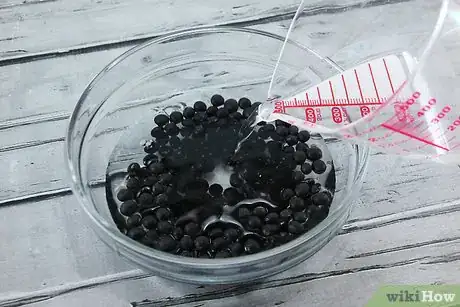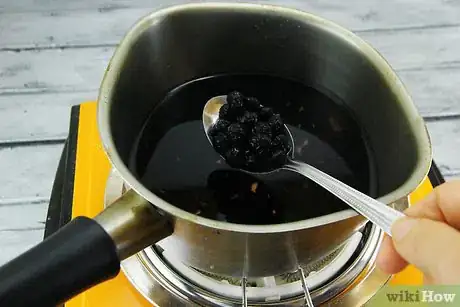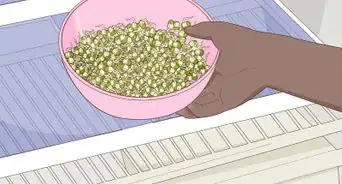This article was co-authored by Jerran Boyer. Chef Jerran Boyer is a Nutrition-Focused Professional Chef and the CEO of Health Nut Chefs. Chef Jerran has over 20 years of experience as a private chef. She and her team specialize in providing healthy, fresh-prepared meals designed with each client’s taste and dietary needs in mind. She and her team offer both personal, part-time chef services and private, full-time chef services in New York, New Jersey, and the Los Angeles area. Chef Jerran received her BS in Business Administration from the University of South Florida, a degree in Culinary Arts from Florida Culinary Institute, and a Plant-Based Nutrition Certificate through Cornell University.
This article has been viewed 94,040 times.
Fermented beans can be a tasty snack or side dish—they are different from black beans used in Mexican and Latin cuisines, and are well-suited to Asian dishes. Fermenting your own beans is a surprisingly simple process. Simply cook and flavor your beans and then let them ferment in airtight jars. When you're done, you will have delicious fermented beans to enjoy.
Steps
Cooking and Flavoring Your Beans
-
1Soak your beans for 24 hours. Place your black beans in warm water in a warmer place in your home. For example, if your kitchen tends to be cozier, place your black beans in a bowl of warm water there. When fermenting beans, they need to soak at least 24 hours before cooking.[1]
- When fermenting beans, you need to start with dry beans rather than canned beans.
-
2Cook the beans slowly with plenty of liquid. After 24 hours have passed, drain the beans using a colander. Then, you can cook them over the stove. Add some water to the beans. There is no precise amount of water to add, but more liquid is generally better. Make sure the beans are at least covered.[2]
- To cook your beans, bring them to a boil. Let them boil for 10 minutes before reducing the heat to low. Simmer the beans for 40 minutes to an hour.[3]
Advertisement -
3Add in spices. Spices should be added to taste and it's up to you which spices you want. Black beans tend to pair well with spices like garlic powder, onion powder, cumin, cilantro, and fresh herbs.[4]
Fermenting Your Beans in Jars
-
1Add in your chosen culture. A culture helps beans ferment. You should add about a tablespoon of culture (15 mL) per cup of beans (240 mL). Cultures can be purchased online or at a health food store. Any of the following would be a good culture to ferment black beans:[5]
- Whey culture
- Powdered starter culture
- Kombucha
- Brine from lacto-fermented vegetables
-
2Break the skins. After mixing in your culture, gently mash the beans using a spoon. This will break the skins slightly and gently bruise the beans. This allows the culture to to bet past the skins and into the starch of the beans. The culture then converts the starch into probiotics.[6]
-
3Store your beans in jars. Beans need to process for several days to complete the fermenting process. Find a sealed container, such as a jar. Fill the container with your beans and seal the lid tightly. Place the jars in a warm place in your home where they will not be disturbed.[7]
-
4Release gas as needed. Keep an eye on the jars while your beans are processing. When the lids are protruding, this means too much gas is building up in the jars. Open protruding jars to release the gas and then reseal them.[8]
- Check on the beans a couple of times a day to see if any gas has built up.
Eating and Storing Fermented Beans
-
1Add fermented beans to salads and dips. Fermented beans can be sprinkled over salads to add some extra nutrition and a funky umami flavor. You can also mash fermented beans into a rich, flavorful dip to serve with things like tortilla chips.[9]
- Fermented beans can also be eaten on their own as a snack.
- They pair well with garlic, ginger, and other Asian ingredients.
- They also go well in braised meats, tofu dishes, and soups..
-
2Store your beans properly. After your beans have fermented, you can keep storing them in the airtight containers you used to process them. Keep your beans in the fridge.[10]
-
3Discard your beans after six months. Date your fermented beans when storing them. This way, you can keep track of when to throw them away. Fermented beans generally only last around six months.[11]
Community Q&A
-
QuestionHow long should the beans ferment?
 Community AnswerIt usually takes nine to 12 hours for the beans to ferment.
Community AnswerIt usually takes nine to 12 hours for the beans to ferment. -
QuestionCan these be used in Chinese dishes that call for fermented black beans? What kind of black beans are you using? Black soybeans or black turtle beans?
 Ken DanieliCommunity AnswerThe recipe here is using Chinese use black soybeans, which aren't the same as black turtle beans we use here for Mexican food.
Ken DanieliCommunity AnswerThe recipe here is using Chinese use black soybeans, which aren't the same as black turtle beans we use here for Mexican food. -
QuestionHow does a can of black beans turn out as fermented beans?
 Ken DanieliCommunity AnswerYou must use dried beans, not canned. Canned beans are just going to rot.
Ken DanieliCommunity AnswerYou must use dried beans, not canned. Canned beans are just going to rot.
References
- ↑ http://www.culturesforhealth.com/learn/natural-fermentation/fermenting-beans-and-legumes/
- ↑ http://www.culturesforhealth.com/learn/natural-fermentation/fermenting-beans-and-legumes/
- ↑ http://www.cookforyourlife.org/recipes/basic-black-beans/
- ↑ http://www.culturesforhealth.com/learn/natural-fermentation/fermenting-beans-and-legumes/
- ↑ http://www.culturesforhealth.com/learn/natural-fermentation/fermenting-beans-and-legumes/
- ↑ http://www.culturesforhealth.com/learn/natural-fermentation/fermenting-beans-and-legumes/
- ↑ http://www.culturesforhealth.com/learn/natural-fermentation/fermenting-beans-and-legumes/
- ↑ http://www.culturesforhealth.com/learn/natural-fermentation/fermenting-beans-and-legumes/
- ↑ http://www.culturesforhealth.com/learn/natural-fermentation/fermenting-beans-and-legumes/
About This Article
Fermented black beans make a tasty snack or side dish, and fermenting your own beans at home only takes a few days. Start by soaking dried beans in warm water for 24 hours. Drain the liquid, then fill a pot with the beans and some fresh water and bring it to a boil. Once it’s boiling, turn the heat down and let the beans simmer for 40 minutes to an hour, or until they’re tender. To ferment the beans, you’ll need to add 1 tablespoon of culture for every cup of beans. You can use whey culture, powdered starter culture, kombucha or brine from fermented vegetables. Mix in the culture, then gently mash the beans just enough to break their skins, which will help the culture work its magic. Store your beans in an air-tight jar in a warm place for several days. Every couple of days, open the lid to release built-up gases. To learn how to properly store your beans, read on!



























































